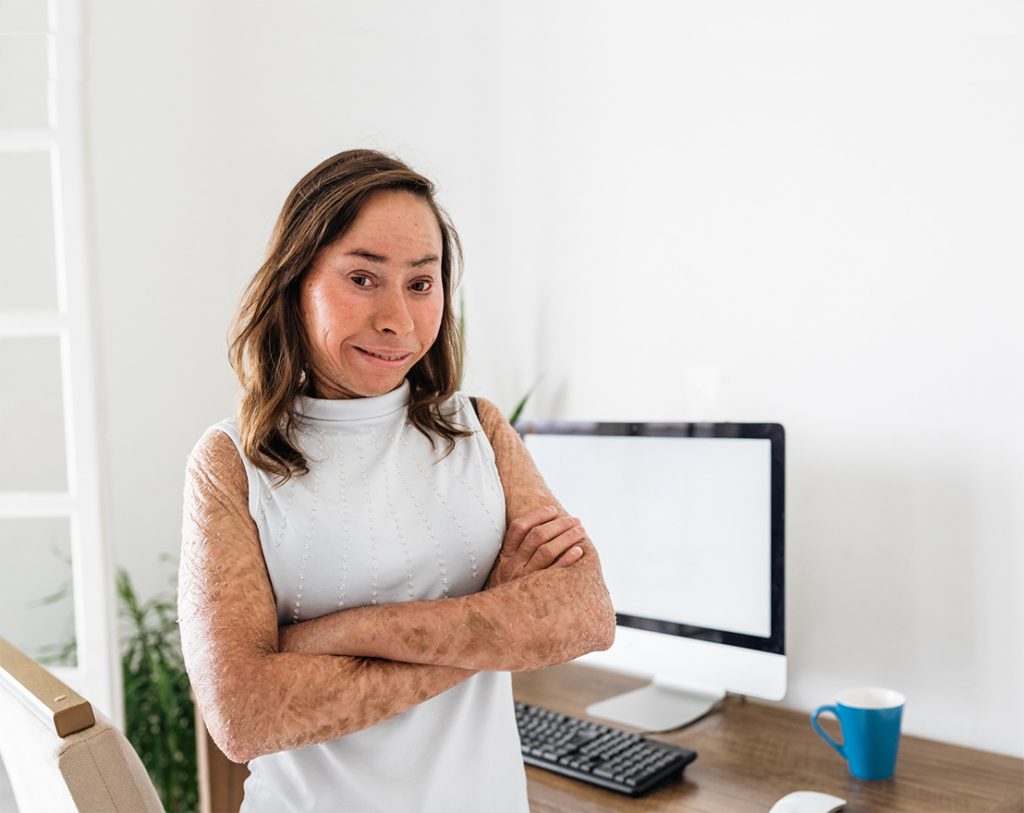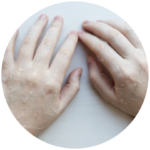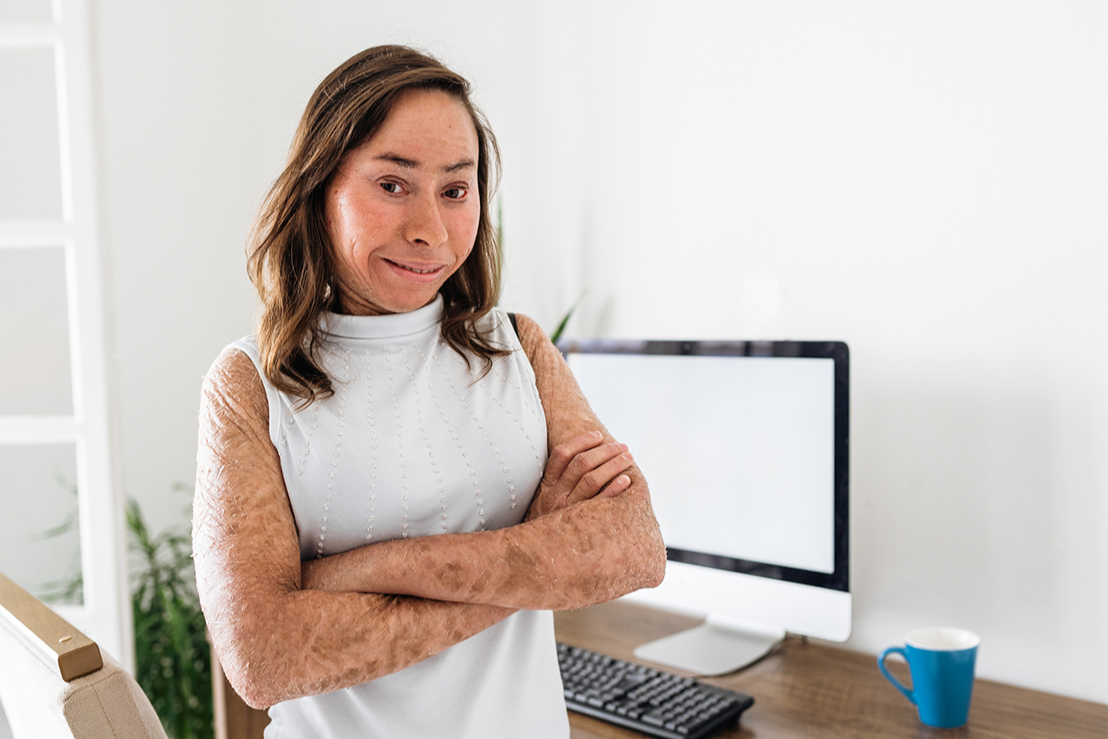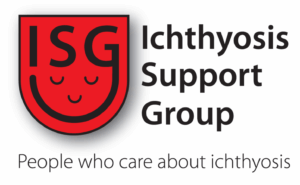What is Ichthyosis?
Ichthyosis is a group of rare genetic skin conditions that cause dry, scaly skin.1 Most forms are inherited genetically, with symptoms appearing at birth, or shortly after.1,2 There are at least 20 different types of ichthyosis, each with different levels of severity and prevelance.1
The main symptoms of ichthyosis are very dry, scaly, flaky, thick and rough skin.1 While ichthyosis can’t be cured, treatments can help reduce the scaling and improve comfort for people living with the condition.1, 2

Some of the types of ichthyosis are:
Ichthyosis Vulgaris
Ichthyosis Vulgaris is the most common form of inherited ichthyosis (affecting 1 in every 250 births), it’s usually mild and can get better as you get older.1,3 Ichthyosis Vulgaris can also appear or occur later in life due to factors such as other medical conditions.1,2 It is characterised by fine, white to grey scales on the abdomen, arms and legs, whereas the face, elbows, armpits and knee creases usually remain unaffected.3
X-linked Ichthyosis
X-linked Ichthyosis predominantly affects males, and occurs in roughly 1 in 6,000 births.1,3 Some newborns may present with scaly skin, followed by the development of fine scales on the torso and limbs during infancy.3 The condition can vary in severity and tends to improve in warmer weather and as the person grows older.3
Autosomal Recessive Congenital Ichthyoses
There are three main types of ichthyoses in this group: Congenital Ichthyosiform Erythroderma, Lamellar Ichthyosis and Harlequin Ichthyosis.3 These conditions tend to have more severe symptoms and are rarer.1,3
For more information, please see the British Skin Foundation website.
Epidermolytic Ichthyosis
Epidermolytic Ichthyosis is a rare inherited ichthyosis. At birth, the baby’s skin is very fragile and may blister easily, sometimes needing intensive care.4 Over time, the skin becomes thickened, red or dark, especially in creases, and infections are common.4
Syndromic Ichthyoses
Syndromic ichthyoses are very rare inherited conditions that cause scaly skin along with symptoms in other parts of the body.5 Unlike non-syndromic types, which only affect the skin, syndromic ichthyoses involve multiple organ systems.5
Misconceptions about Ichthyosis
Sadly, people living with ichthyosis often face societal misconceptions about their condition, which can damage their self-confidence and opportunities. It’s crucial to raise awareness about the condition to create a more inclusive and supportive environment for everyone.
See some of the common misconceptions busted below:

Myth: “Ichthyosis is contagious”
Fact: Many people mistakenly believe that ichthyosis is contagious or caused by an infection. However, ichthyosis is actually a genetic condition and cannot be spread from person to person.

Myth: “Ichthyosis is due to poor hygiene”
Fact: Ichthyosis isn’t caused by poor hygiene! It’s a genetic condition caused by mutations affecting skin cell turnover and barrier formation. Proper skincare is crucial for management of the condition, but hygiene isn’t the culprit.

Myth: “All cases of ichthyosis are severe”
Fact: Some types of ichthyosis, like Harlequin Ichthyosis, are very severe, while others, such as ichthyosis vulgaris, are milder and more manageable. Public perception often highlights the rare, striking cases, overshadowing the more common, less severe forms.

Myth: “Life can’t be normal with ichthyosis”
Fact: Many people assume that individuals with ichthyosis are severely impaired or cannot lead fulfilling lives. In reality, many people with ichthyosis lead active, productive lives when they have access to the right treatment and support.
What can help manage the condition?
Most types of ichthyoses cannot be cured, but there are many methods to help manage the symptoms!
- Frequently use emollients like creams, lotions, or ointments to trap moisture and relieve dryness and scaling.1
- Ideally use emollients when your skin is still wet after having a bath or shower.6
- Opt for fragrance-free, soap-free cleansers that do not strip the skin of its natural oils when washing.7
What makes Ichthyosis different to Eczema and Psoriasis?
The scaling associated with ichthyosis typically affects most, if not all, areas of the skin and remains fairly consistent over the years.8 This contrasts with skin conditions, such as eczema and psoriasis, where scaling is limited to specific areas and frequently changes its pattern.8 Notably, up to 50% of individuals with ichthyosis vulgaris also have features of atopic eczema, highlighting the overlap between these skin conditions.9
Where can you look for further information?
For more tips on managing ichthyosis, have a look at the Ichthyosis Support Group. They have lots of useful resources on their social media pages and website about specific ichthyosis conditions.
- https://www.nhs.uk/conditions/ichthyosis/ (Accessed May 2025)
- https://www.webmd.com/skin-problems-and-treatments/what-is-ichthyosis (Accessed May 2025)
- https://knowyourskin.britishskinfoundation.org.uk/condition/ichthyosis/ (Accessed May 2025)
- https://cdn.bad.org.uk/uploads/2021/12/19173955/Ichthyosis-PIL-Aug-2023.pdf (Accessed May 2025)
- https://pmc.ncbi.nlm.nih.gov/articles/PMC10842576/ (Accessed May 2025)
- https://www.bad.org.uk/pils/ichthyosis/ (Accessed May 2025)
- https://www.ichthyosis.org.uk/winter-skin-care-tips (Accessed May 2025)
- https://sussexcds.co.uk/patient-information/ichthyosis/ (Accessed May 2025)
- https://www.pcds.org.uk/clinical-guidance/ichthyosis (Accessed May 2025)
EPI1010451GGG1_MAY2025

